Passion fruit jelly is a staple on Hawaii breakfast tables, but it’s easy to make your own! Use fresh juice or juice from the freezer to make this tangy sweet lilikoi jelly. It will bring a tropical flavor to your morning toast, or use it in recipes like shortbread cookie bars in place of lemon.
This lilikoi gingerade is another great way to indulge in the flavor of passion fruit!
Originally published in August, 2011; this post has been updated.
What is Lilikoi?
Otherwise known as passion fruit, liliko‘i fruit is Mother Nature’s answer to a SweeTart. The first sour bite of a liliko‘i will jangle all the way back to your jawbone.
Stick with it, though, and you’ll catch the tropical sweet undertones if this much-loved fruit. Filled with small black seeds wrapped in a juicy orange membrane, lilikoi grows on a vine that can get rambunctious in our mild climate.
While I’m told there have been attempts to eradicate the vine as a pest, I consider myself lucky to have liliko‘i fruit growing in my backyard.
5 Easy Steps to Transform Your Pantry!
Ready to switch from store bought to homemade? Let me help you make some changes! Grab my FREE five-part guide to getting started.
There are a number of different varieties of lilikoi here; some have yellow skin, some have purple skin, and one — often called Jamaican lilikoi or peach lilikoi — has light orange skin that’s a bit velvety. It tends to be sweeter than the others.
For another tropical flavor for the pantry, try this loquat jam.
The Handcrafted Pantry

Ready to DIY your pantry with more wholesome ingredients? Check out my ebook, The Handcrafted Pantry! Filled with delicious recipes for some of your favorite condiments, snacks, and toppings, it’s the guide you need to start skipping packaged products and embrace homemade.
Passion Fruit Jelly or Passion Fruit Jam?
If you’re not sure which one you’re after, go over here to read about the difference between jam and jelly.
Some people make liliko‘i jam, retaining the seeds — or at least some of them — in the final product. Passion fruit seeds are really hard. And they’re not small. They’re about 1/8′ across.
I don’t care for them in my passion fruit spread, but if you like crunchy jam, you may like it this way.
Passion fruit jam is certainly easier to make than passion fruit jelly, as you can skip the juicing step. (Which is really the most time consuming step.)
This recipe is somewhat of a hybrid between jam and jelly. A true jelly is made with pure juice and results in a clearer product. Because I’m including the pulp, this might be more accurately described as a seedless passion fruit jam. Whatever you call it, it’s definitely a winner for the pantry!
Ingredients
Passion fruit pulp — If you have access to fresh fruit, lucky you! But if not, you can use prepared passion fruit pulp, often available in the frozen food aisle.
Sugar — Sugar is required for the setting of the jam, but it also balances the tart rhubarb. Use your favorite brand of granulated cane sugar. I prefer organic.
Pectin – This recipe is made using Pomona’s Universal Pectin. This is the only pectin I use anymore as it allows me to use much less sweetener. The standard pectin brands use an obscene amount of sugar in my opinion, often requiring equal amounts of sugar and fruit! This product uses a low methoxyl method and calls for using two different ingredients, which are included in the box: pectin (the large packet) and calcium powder (the small packet). The dry pectin is mixed with the sweetener before being added to the fruit. The calcium water is added directly to the fruit.
Juicing Passion Fruit
Use a sharp knife (I prefer a serrated one) to cut through the passion fruit shell. You can cut the fruit however you like, but I’ve found that cutting about an inch off one end saves time, rather than cutting each passion fruit in half.
If you cut the fruit in half, you’ll end up with pulp in each half, and you’ll need to handle it twice.
Shifting the knife closer to one end means that the passion fruit pulp ends up in one half most of the time.
Use a knife or spoon to scoop the pulp out of the shell and into your blender.
I like to preserve this passion fruit jelly in small jars so that I can take them with me as gifts when I visit family and friends on the mainland.
Separating the Passion Fruit Pulp From the Seeds
Once the blender container is full, run it on medium speed for 30 seconds or so. Your goal here is to break the fibrous attachment between the pulp and the passion fruit seeds — without actually chopping up the hard black seeds.
Run the pulp through a chinois, food mill, or fine sieve to remove the seeds. Return the thick pulp and seeds to the blender and add twice as much water as pulp. (1 cup pulp, use 2 cups water.) Blend for 30 seconds again, strain, and add this juice to the full-strength first batch.
Making the Jam
Bring the liliko’i juice and calcium water to a boil in a large pot.
While this is heating, combine the sugar and pectin in a bowl, mixing thoroughly. Add sugar mixture to boiling juice and return to a boil. Remove from heat and proceed with canning instructions.
Canning Jam
You’ll need special canning jars, lids, and rings (read more about canning equipment here) to make this homemade jam shelf-stable, but the process isn’t difficult.
Use quarter-pint, half-pint, or pint jars for this recipe.
Once the jars are filled, you’ll process them in a water bath. What this means is you’ll put the filled and sealed jars of jam into boiling water and heat them for ten minutes. This assures that the jars will seal well.
You might be able to use a large pot, rather than a special water bath canner.
Place hot jars on a countertop lined with a kitchen towel and allow to cool fully. As they cool, you’ll hear the little “tink” sound of the jars sealing. Store any unsealed jars in the fridge and use those first. (This is unusual, but it does happen once in awhile.)
Remove the ring from each sealed jar, rinse to remove any jam residue, and store (without the ring) in a cool place, such as the pantry.
Here’s a more detailed look at canning jam and jelly and a collection of even more jam recipes!
🍅 Safety First!
Canning is an excellent way to preserve food for the pantry, but there are some important safety considerations to keep in mind. The recipes on this site have been made following safe canning procedures by a certified Master Food Preserver.
- Know the difference between water bath canning and pressure canning. Low acid items must be pressure canned for safety.
- Altering ingredients may change the recipe’s pH, posing a safety issue. I highly recommend investing in pH paper to test your products for acidity level when canning. Note: For safe water bath canning, the Hawaii Master Food Preservers suggest a pH of 4.2 or lower in the tropics. In other regions, the recommended pH is 4.6 or lower.
- Use the proper jars and lids. Never reuse lids, with the exception of the Tattler or Harvest Right hard plastic lids that are intended for such a purpose.
- For more on canning equipment, please go here.
- Want to learn more? The National Center for Home Food Preservation is the go-to resource for safe canning information.
Using this Jam
This delicious jam is one of my favorites for spreading on toast, but try adding it to a glass of jam seltzer, too!
FAQs
Do I need to use sterilized jars?
According to the National Center for Home Food Preservation, canning jars only need to be sterilized if they are processed for fewer than 10 minutes. Because this recipe calls for a process time of ten minutes, you do not need to sterilize the jars – the canning process is sufficient. DO start with clean jars, though!
How long does homemade jam last?
For best quality, homemade jam should be used within a year or so, though as long as the seal remains intact, the product inside the jar should be good.
Related: Easy Canning Recipes for the Novice Home Canner
★ Did you make this passion fruit jelly? Don’t forget to give it a star rating below!
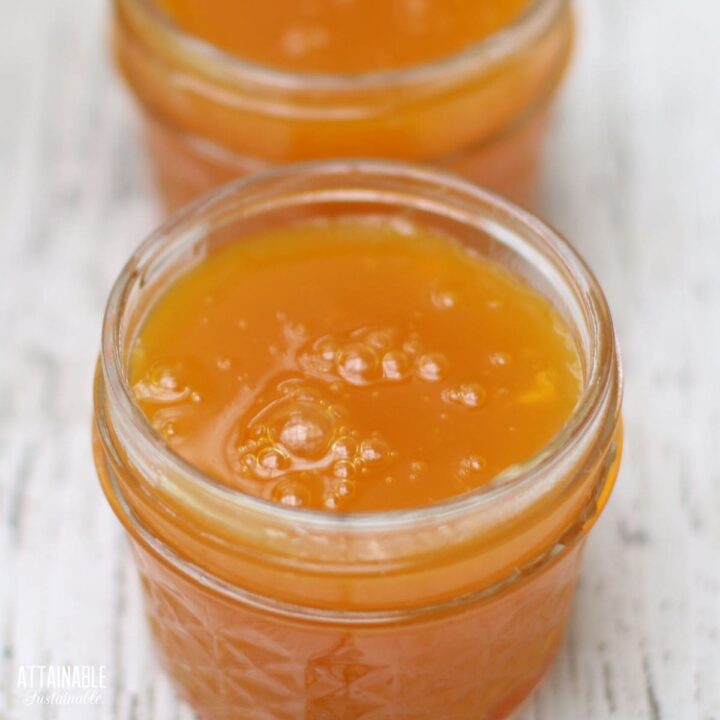
Passion Fruit Jelly
Liliko‘i -- or passion fruit -- has a delicious tropical flavor. Use the juice from this fruit to make a batch of jelly for the pantry.
Ingredients
- 8 cups liliko‘i juice
- 4 teaspoons prepared calcium water (from Pomona's Pectin package)
- 4-5 cups granulated cane sugar
- 6 teaspoons pectin (from Pomona's Pectin package)
Instructions
PREPARE FOR CANNING
- Prepare the calcium water: Combine ½ teaspoon calcium powder (from the small packet in the box of Pomona’s pectin) with ½ cup water in a small jar. Screw on a lit and shake until well-combined. You'll have more than you need for this recipe. Store the excess in the refrigerator for use in making additional jam or jelly recipes.
- Wash the jars you'll use, making sure each is clean and free of nicks in the rim, which could impede sealing.
- Wash the lids and rings in hot soapy water. (If you're using non-Ball brand lids, prepare as suggested by manufacturer.)
- Place empty jars in a canning pot or large stock pot with enough water to cover by an inch or two, cover pot, and set on high heat. It can take awhile for the water to heat, so get it started before you begin making the recipe.
MAKE THE JELLY
- Measure passion fruit juice and prepared calcium water into a large stock pot. Bring to a boil, stirring frequently.
- Meanwhile, combine sugar and pectin in a bowl. Stir very thoroughly (and I mean thoroughly) to prevent clumping.
- When juice boils, add sugar mixture and stir vigorously to dissolve the pectin. Return to a boil (about 5 minutes) and then turn off heat.
- If you're concerned about your jelly looking pretty, skim off the foam that develops in cooking. It's totally edible, but if you're giving jars as gifts or entering in your county fair, it's just not as pretty.
CANNING THE JELLY
- Ladle hot jelly into quarter-pint, half-pint, or pint sized jars, leaving 1/4" head space. A canning funnel makes this easy.
- Wipe jar rims to remove any jelly that may have spilled. A clean rim is essential to a good seal.
- Set jar lids in place. Screw bands on finger tight.
- Use a jar lifter to gently submerge jars into hot water in the canning pot. Water should cover the top of the jars by an inch. The water will cool somewhat in reaction to the addition of the jars. Return the water to a boil and then set the timer.
- Process for 10 minutes 0-1,000 feet altitude; add an additional minute for every additional 1,000 feet in elevation.
- Remove jars from water using the jar lifter and transfer to a solid, towel-covered surface. Allow to cool for 24 hours.
- Check seals. Lids should be solid and pulled down tight. (if they flex and pop, the jar didn’t seal; put unsealed jars in the refrigerator and use those first).
- Remove rings and wash outsides of jars. Store in a cool, dry place.
Notes
Please see full post above for how to juice passion fruit.
Makes 9 half-pint jars
This recipe is made using Pomona’s Universal Pectin. This is the only pectin I use anymore as it allows me to use much less sweetener. The standard pectin brands use an obscene amount of sugar in my opinion, often requiring equal amounts of sugar and fruit! This product uses a low methoxyl method and calls for using two different ingredients, which are included in the box: pectin (the large packet) and calcium powder (the small packet).
Store opened jars of home made jam in the fridge for up to a month.
Boiling lids or heating above 180°F as once recommended can damage the sealing compound.
SOURCE: Adapted from Pomona's Universal Pectin "create your own" method.
Nutrition Information:
Yield: 40 Serving Size: 1 gramsAmount Per Serving: Calories: 414Total Fat: 0gSaturated Fat: 0gTrans Fat: 0gUnsaturated Fat: 0gCholesterol: 0mgSodium: 31mgCarbohydrates: 107gFiber: 0gSugar: 106gProtein: 0g
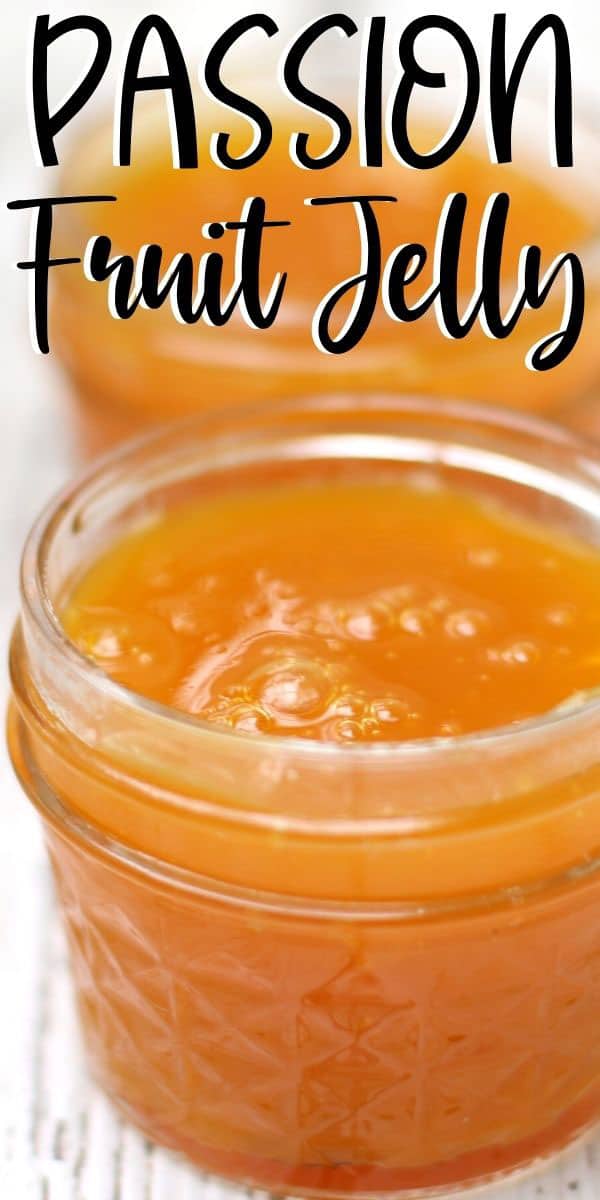

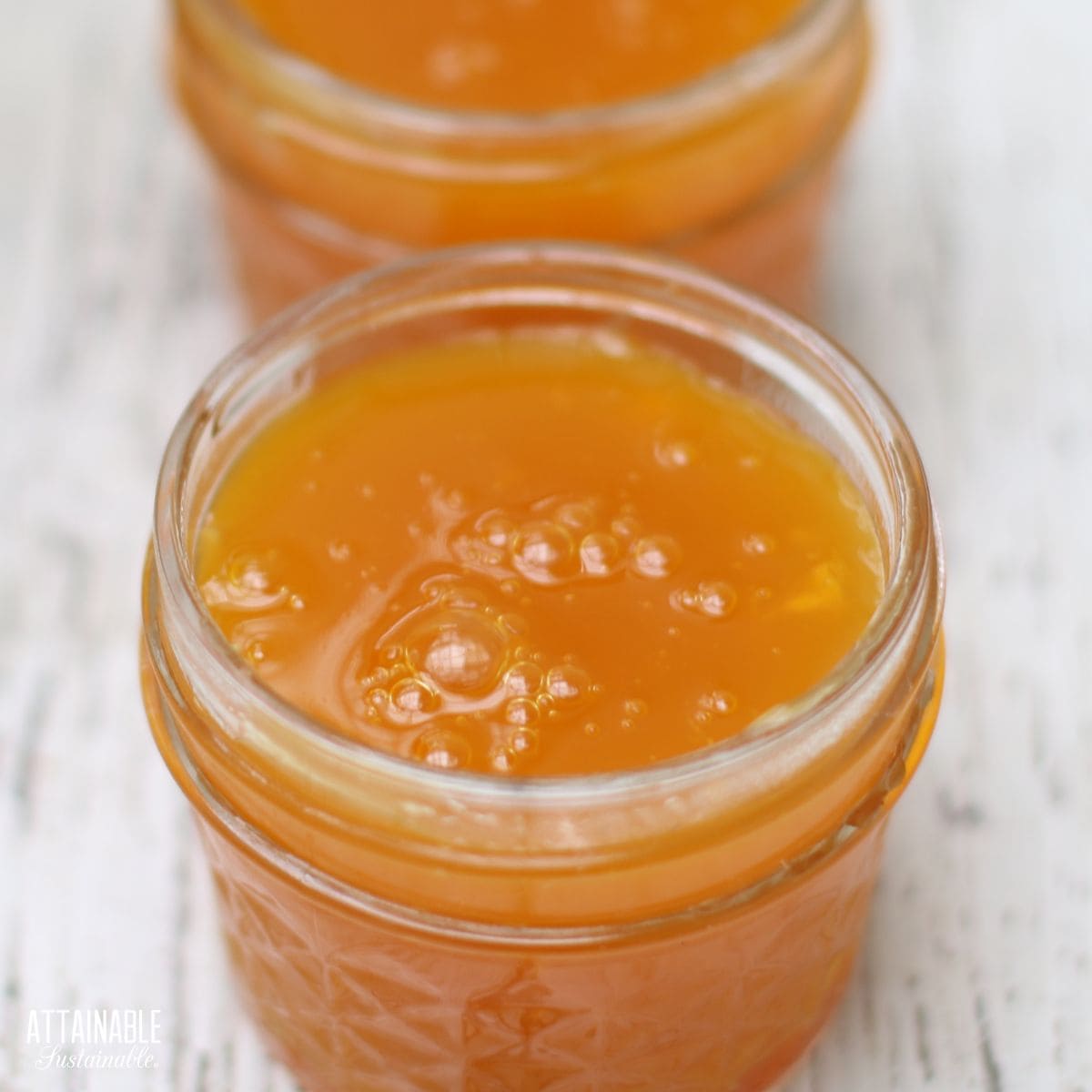
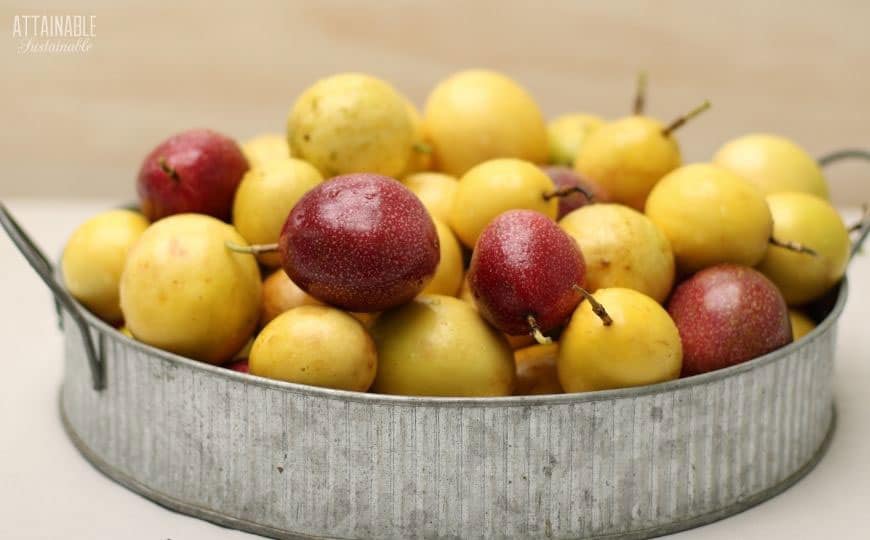

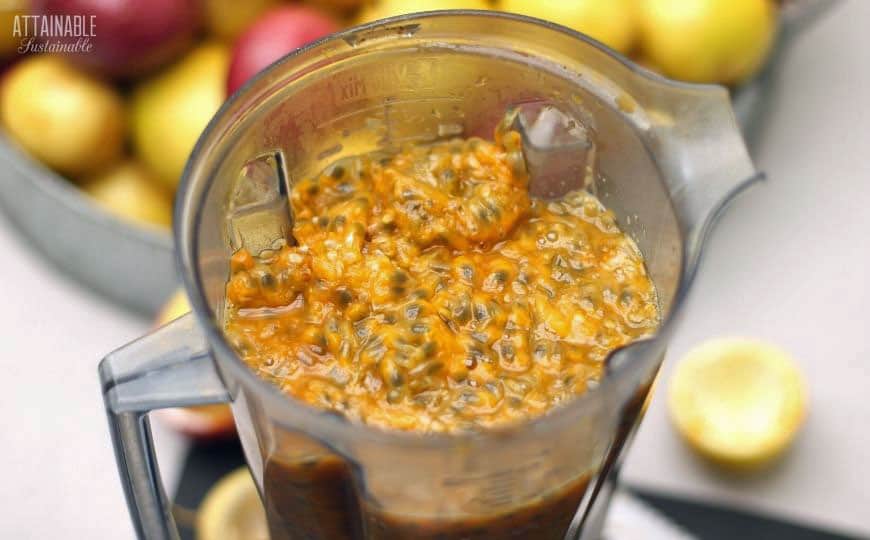
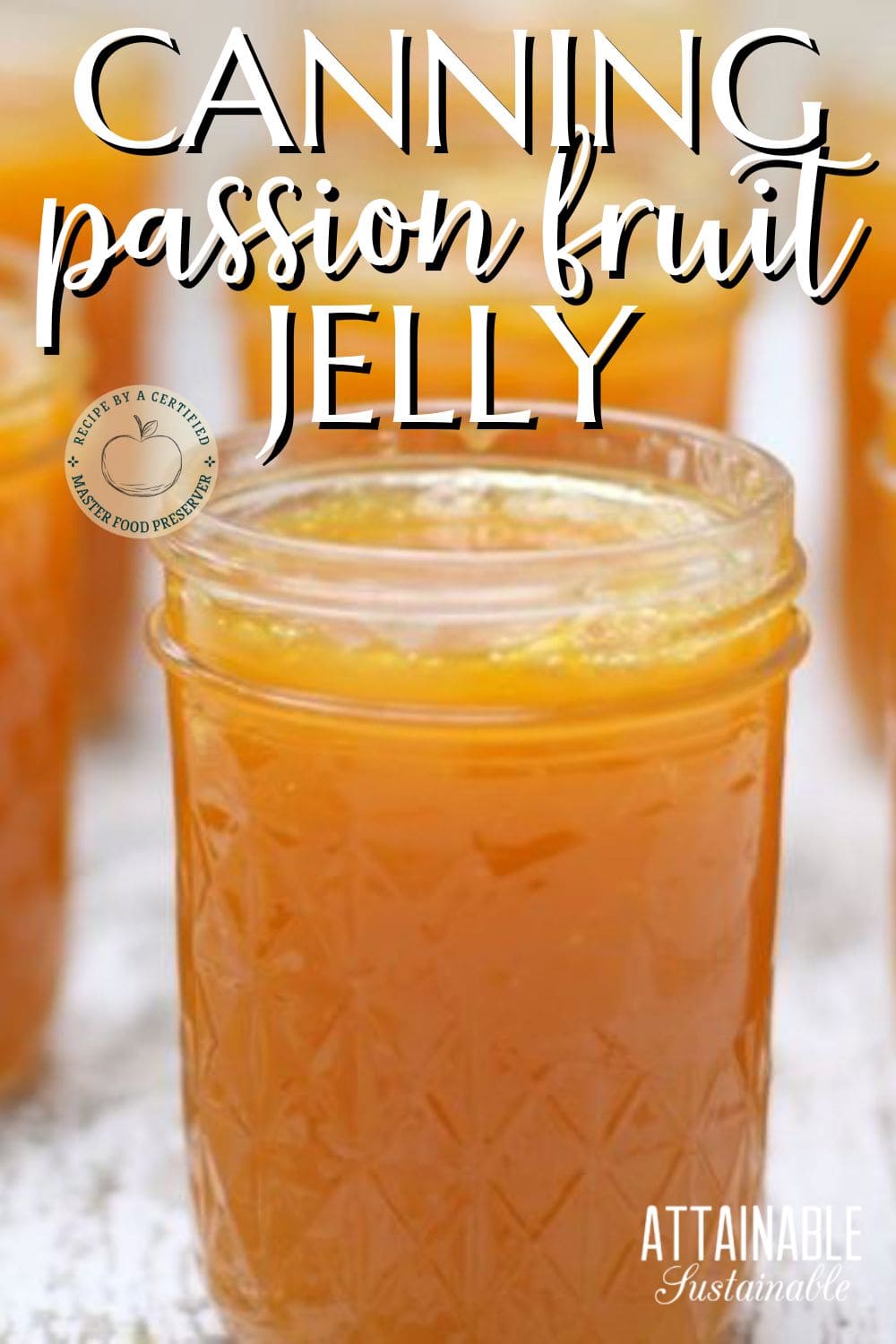
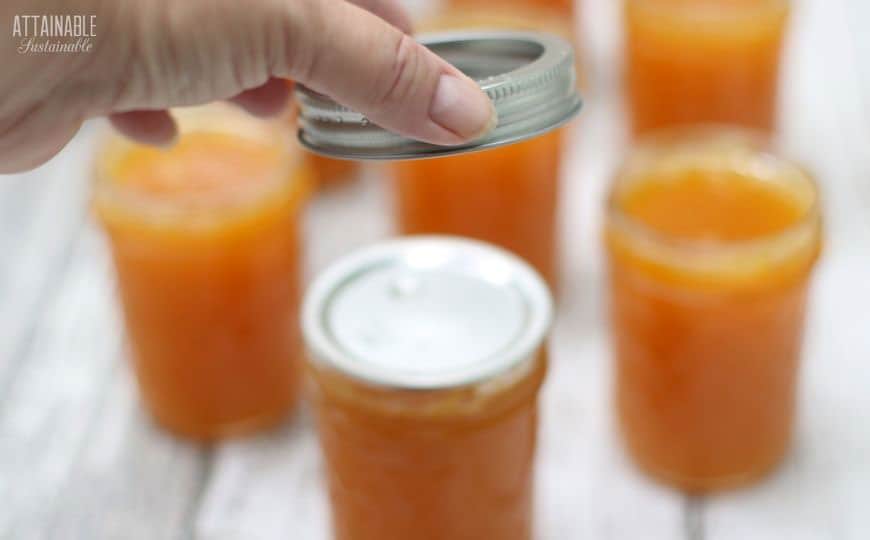
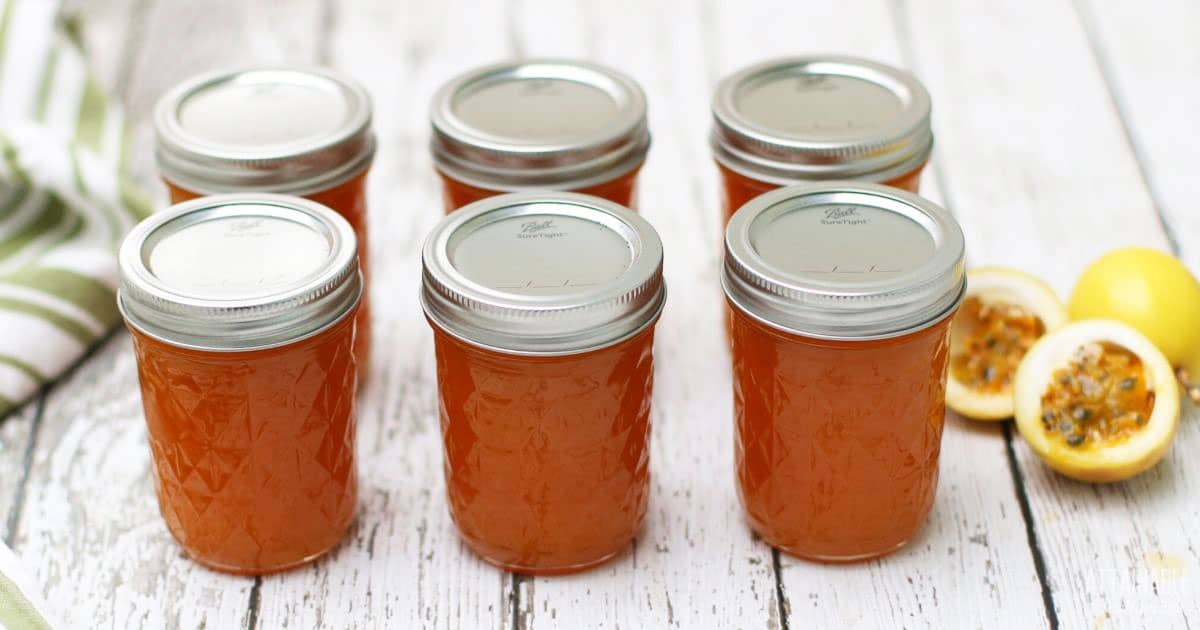






What would the portion of regular pectin and sugar for the recipe? Thanks.
I don’t know; I don’t make it this way – sorry!
Do you have a pH paper recommendation? (Several suggested links are not working for me.) I’d love to know if you have a guava jelly recipe, too! And POG!
Hi Kris.
Do you have any experience canning coconut milk?
Sorry, no I don’t.
What do you think about using honey instead of sugar. Love Pomona pectin
I think it would be great.
I have passion fruit pulp I bought to make jam. I’ve never heard of calcium water. Is this something I need to make my jam turn out. And if so where do you get it ?
Thank you
This recipe calls for a specific brand of pectin that uses calcium water (it’s in the packet). I get it at my health food store, but it’s available online, too. I prefer this brand because it allows me to use less sugar, but you could also use other brands of pectin. I’m not sure on measurements of those, though.
Hi! I’m going to try this soon- how long do you think the jelly will safely last in the fridge once you open a jar?
Thank you!
I’d say 4-6 weeks or so.
KRISS. 40 servings means? How many ounces would I get?
Sorry! This recipe ‘form’ I use asks for *servings. This will make 4-5 pints.
I finally found some passion fruit puree abd made this. Yumm!
Love your recipe. I love it without so much sugar as the regular jelly recipe. I really like the fresh lilikoi taste. So to add even more fresh flavor to your jelly recipe, I reserve 1 cup of lilikoi juice and add it immediatly after the second boiling. Thanks for sharing.
Our vines give lots of juice, which I package in a zip-lock freezer bag, and freeze in our freezer until I want to use it. I’ve made quite a few lilikoi cheesecakes, which we love, and make nice presents for others. I’m planning to can some jelly today, so I have the required amount thawed and ready to go. I have found that the less heat the juice is subjected to the stronger the flavour. So, I’ll probably try adding the juice after boiling, and hope it sets up well. I’ll also be using regular pectin (I have liquid and powder versions), so I’ll let you all know how it works out.
I tried going to site “recipes from Brazil.com” but found it was no longer an active site. It appears to be trying to sell the domain website.
Do you share your Lilikoi cheesecake recipe would love to try it pleaae
My children were born and raised in Brazil, and their favorite fruit is still passion fruit, aka maracuja. It was in season pretty much all year. My youngest loved mousse de maracuja so much that I used to make it for him instead of birthday cake.
I also used to make passion fruit jelly. I couldn’t get commercial pectin, so I just “made do”, which wasn’t hard since the seeds and skin of passion fruit have a lot of natural pectin in them. I used to just chop the whole fruit up, soak in over night, simmer for a couple of hours, drain in a jelly bag, add a cup of sugar to a cup of juice, and boil it until it set. It worked just fine.
Interesting. Never thought to use the whole fruit and then drain it in a jelly bag….Thanks!
Adapted your recipe to make liliko’i ginger jelly today. I’m a canning virgin no more! Thank you for making my first experience easy! Now I’m starting another batch of liliko’i wine… yum!
I had my first taste og lilikoi ginger jam and now want to make it. I have my passionfruit and ginge, what is your recipe an why the calcium water and will any pectin work.
I’d just juice the ginger and replace a portion of the liliko‘i juice. Just guessing – maybe a quarter cup? (I guess it depends how gingery you like it!)
I use Pomona brand pectin because it allows me to use less sugar than the standard brands. The calcium powder comes with the Pomona pectin.
Hope it turns out great!
Thank you so much, I will let you know how it goes!
I found two. They are similar. The second has a good picture. So delicious
https://www.maria-brazil.org/mousse_de_maracuja2.htm
https://recipesfrombrazil.com/passion-fruit-mousse-mousse-de-maracuja/
I planted a passion fruit vine for Frugal Man this past summer-a black one though, not a yellow one. It is establishing well and we should get some fruit off of it this coming summer. Not sure it will be enough to can extra, but I’ll keep this in mind!
Have never tasted this. Now I’m curious. Will I find it ever at the local supermarket?
I suspect not, unless you have access to a high end gourmet store. It IS available on Amazon, though – search for Hawaiian Sun Passion Fruit Jelly.
Oh, I love passion fruit. I haven’t had it since I lived in Brazil. They make a wonderful passion fruit mousse there that is just the perfect sweet tart combo (in Portuguese it’s called creme de maracuja). And the juice, so delicious! Although, it always made me so sleepy. I had to be careful not to drink it at lunch (which is the main meal of the day there). If you are interested, I might be able to dig up that mousse recipe, or translate one from the net. I can taste that mousse right now. Those were two of my favorite things there. I miss all those tropical fruits.
That sounds *fabulous! Why did it make you sleepy? I’d certainly give it a whirl if you were to share a recipe…
I love liliko’i and am also lucky to have a couple of vines that grow wild on our property! I’ve never attempted to make the plain liliko’i jelly, but I do make liliko’i syrup quite often and from that, I can also make liliko’i vinaigrette, and passion fruit hot pepper jelly, which we love!…I also have made a liliko’i flavored rice pudding (TDF) and a fantastic chocolate cake with liliko’i and cream cheese icing….
https://www.gather.com/viewArticle.action?articleId=281474977417898
https://www.gather.com/viewArticle.action?articleId=281474977432020
I find I don’t use the liliko‘i/hot pepper jelly as much as the regular jelly! Thanks for sharing these links.